Review best practices, new safety code before installing, maintaining gas lines
by Thomas F. Armistead, Consulting Editor
Planning and safety are two of a powerplant manager’s principal responsibilities, and both have become more challenging as a result of recent developments.
The tug-of-war inWashingtonover renewable-energy goals has bogged down in Congress. Legislative deadlock also has pushed the regulation of greenhouse-gas emissions and other pollutants over the fence to the EPA, which is proceeding cautiously as it writes still more rules. The planning of capital improvements in such an environment is especially challenging given the financial risks involved.
Additionally, fatal explosions of natural gas at an industrial plant in 2009 and a combined-cycle facility in 2010 motivated the development of NFPA® 56, a new standard for fuel-gas piping systems that governs commissioning and maintenance activities at powerplants for the first time.
Among the positives for owner/operators of gas-fired plants: The boom in gas production from shale formations over the last decade has helped tame the fuel’s notorious price volatility. Shale-gas production increased at an impressive average annual rate of 17% from 2000 to 2006, and then took off—growing 48% year over year, until 2010, says the US Energy Information Administration. Proven gas reserves are at their highest levels since 1971; since mid 2008, gas has been competitive with coal on price.
The strong probability that the ballooning reserves of shale gas will keep gas prices low for several more years at least, together with the EPA’s July 7 announcement of the Cross-State Air Pollution rule (the near certainty that the EPA will regulate carbon-dioxide emissions), have prompted some powerplant operators to convert their plants from coal to gas.
Fuel conversion
A case in point is Cornell University, which in 2008, acted to make-over its conventional coal-fired steam plant as a combined heat-and-power (CHP) facility fueled by natural gas. The plant had operated on coal since its construction in 1922, but load growth had created a need for additional thermal capacity. Plus, the university wanted the additional benefit of electrical islanding for reliability.
Cost control for budget certainty was another criterion for the decision. “We traded electrical volatility for natural-gas volatility,” said Timothy S Peer, PE, plant manager. “They are heavily correlated inNew YorkState, and gas can be hedged effectively whereas electricity cannot.”
Moreover, as a top-shelf institution, Cornell strives to set an example of responsible environmental stewardship, with digitally controlled buildings, variable-speed drives for fans and HVAC system pumps, and other environment-friendly campus systems. Converting to gas to reduce the plant’s carbon footprint was in line with that policy.
Peer has been completely satisfied with the conversion to gas, but admits that he started the project ignorant of “the whole process by which natural gas is secured and supplied to the burner tip. It takes more time to manage that than I realized.” Binghamton-based New York State Electric & Gas Corp, the local gas utility, already supplied some gas to Cornell, but its system was constrained and couldn’t supply more for the conversion. Because of that, NYSEG waived the bypass charge Cornell would have incurred for leaving its system to purchase from another supplier.
Peer approached Dominion Transmission Inc, theRichmond(Va)-based interstate gas transmission company whose line passes near Cornell, to arrange for an interconnecting line to his plant. Dominion was fully subscribed, so Cornell had to pay the interstate operator a fee for the uprate required to serve its load, and reimbursed it for designing and constructing the custody-transfer station at the interconnection.
Projects where the customer asks the interstate pipeline for direct service “really aren’t common for us,” said Scott Canterbury, Dominion’s manager for engineering projects. The schedule is “extremely important” to the engineering of the line, and “customers should come to the utility early rather than late,” because delays could crop up and prevent the line’s being available when required, he said.
The Federal Energy Regulatory Commission has preapproved blanket activities, such as metering stations and interconnections, that can be designed into the line as long as they comply with the regulation, but some aspects of a design can’t be modularized that way and must be approved individually by the FERC.
The university engaged Otis Eastern Service,Wellsville,NY, to construct the new 3.2-mile line to the plant, a standard Schedule 40 carbon-steel, seamless, 8-in. pipe certificated at 600 psig but designed for 900 psig to accommodate possible future uprating. Seamless is higher-quality pipe than electric-resistance welded pipe and comes at a cost premium, Peer noted.
But with its own gas line, “our delivery cost is significantly lower” than the NYSEG rate, he said. “When the amortized capital cost of the gas line, with additional O&M expense, is spread over the increase in volumetric flow for natural gas, the unitized dollars-per-dekatherm cost of delivery is 70% less than what it would have cost through the local distribution company.”
At the custody-transfer point, gas is heated, regulated to system pressure, metered, and odorized. Where the line enters the plant, there is another heater, as well as redundant regulators to maintain pressure. There is also temperature control to ensure 50-deg-F superheat above the methane dewpoint. A coalescing filter at the turbine catches particulates and moisture (Fig 1). Dominion operates and maintains the interconnection point, Cornell the equipment at the entry to the plant.
Having its own interconnection has clear benefits for Cornell, but servicing it would entail burdensome regulations, such as drug screening of the entire staff. Instead, NYSEG provides the normal gasline services for a fixed charge under a five-year contract. If emergency service is required, NYSEG is reimbursed for time and materials.
In the process of developing the line, Peer encountered a provision of the New York Code of Rules and Regulations (NYCRR) that governs construction of natural-gas transmission and distribution facilities.
Compliance with this code created some difficulties with local authorities because the project is exempt from the State Environmental Quality Review Act and local approvals. The NYCRR code normally applies to state-franchised pipeline companies, which obtain approval from the NY Public Service Commission. The PSC can give precedence to regional or state needs and override local objections, but explaining this to local authorities took extra effort, said Peer.
Quality control during construction was the same as on other projects, except that the NYCRR requires a full-time environmental inspector on the job site during construction to ensure compliance with the certification. The law also requires an environmental review for the pipeline separate from the CHP’s review. The pipeline review covered route justification, approved land uses, agricultural resource considerations, communications with local government officials, and ecosystem, visual, cultural, and archaeological resources.
Cleanliness. Before entering service, a pipeline must be perfectly clean and spotless, with no dirt or moisture that could damage the gas turbines, said Frank D Perry, Cornell’s energy and sustainability project manager. During fabrication and delivery, the pipe collects dirt and rust and can be damaged. Pigging is necessary to prepare it for service. A pig is a device inserted into a pipe to perform one of several functions—including cleaning and interior inspection, among others. The pipeline contractor performed the operation.
Critical to working safely with gas is understanding that it is most hazardous at low concentrations. When the concentration of natural gas is from 4.3% to 15% of a given volume of air, it can be ignited, said John Puskar, PE, a principal with CEC Combustion Safety Inc, Cleveland. If over 15%, it is too rich to burn; below 4.3%, it’s too lean. These are called the upper explosive limit (UEL) and the lower explosive limit (LEL), respectively. Purging and packing gas pipes must be done in such a way that the gas concentration is kept outside these limits.
To prepare for pigging, the three sectionalizing ball valves were removed from the installed pipe and replaced with short pieces of spool pipe to close the gap left by the valves. The spool pieces were bolted into place and the line was pressurized to 100 psig and then opened several times to clean out loose debris. Next, a sizing pig (Fig 2), consisting of a round, flat aluminum disk, was blown through the pipe from end to end to make sure the pipe diameter had not been compromised during construction. It knocked off loose protrusions such as caked dirt, rust and slag as it went through.
The valves then were replaced and the pipe was filled with water, pumped in behind the pig to force out the air. With water filling the pipe, the pressure was increased to test for leaks. After hydrotesting for 24 hours, the water was drained. The brush pig (Fig 3), a bullet-shaped, poly-covered, foam-filled form sized for the pipe, was then propelled several times through the pipe by compressed air from end to end at about five miles per hour. Strips of wire brush on the pig’s surface abraded the interior of the pipe while the pig helped force out the water. Compressed air then blew out the debris loosened by the pig (Fig 4).
Next came a series of cleaning pigs. These were simple foam pigs that absorbed the moisture and rust. The first ones (Fig 5 left) were wet and, when cut open, had brown rust to the core. The cleaning continued until the last pig (Fig 5 right) showed little rust penetration.
The final pig was the caliper pig (Fig 6), a sophisticated instrument sporting plastic fingers mounted on disks strung together with linked mandrels. Electronic detectors recorded irregularities, such as dents and weld locations, as the plastic fingers passed over them.
An air dryer was connected to the compressor to blow dry air through until the air exiting the pipe reached a dewpoint of –10F. The pipe then was packed with nitrogen to keep the line dry. When gas packing began, the nitrogen slug at the interface with the gas would ensure that the gas concentration would not fall to the explosive range during gas packing. The entire operation took five to six days, Perry said.
Inside the plant, 150-ft-long, stainless-steel 3-in. pipes deliver the gas at 500 psig to the turbines. To limit the number of high-hazard classification areas, and to minimize the amount of particulate matter that could plug the filter at the turbine manifold, the pipes have no mechanical joints outside the turbine skid. Carbon-steel pipes with mechanical joints are still used on the 30-psig gas system serving the duct burners and packaged boilers (Fig 7).
Design engineer GIE Niagara Engineering Inc PC designed the gas-supply piping for easy service and maintenance—providing a dedicated, isolatable system for each turbine and keeping the 30-psig system isolatable from both the new and old plants. Ball valves were installed for isolation purposes because they have two seals for tighter shut-off, said Peer.
Methane detection is a critically important safety function. Natural gas has no odor, so an odorant called mercaptan, injected into the gas where it enters the plant, is “the first line of detection,” Peer continued. Mercaptan provides the characteristic odor that people associate with natural gas. SeveralMSAGasGard™ monitors are installed at critical points in the plant to detect gas leaks before an explosive environment is created (Fig 8).
As a final safety measure, NYSEG performs an annual leak survey on the mainline pipe. NYSEG also does quarterly leak surveys in the regulating station and the plant’s own staff performs an annual “bubble check” survey, using soap and water, on joints and packings inside the plant.


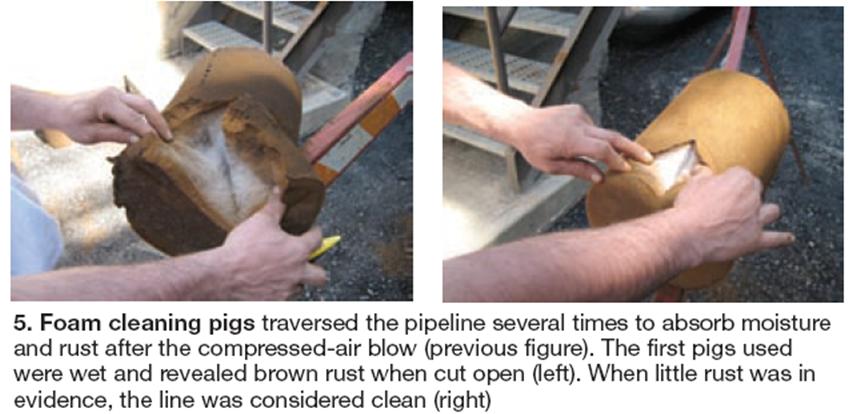
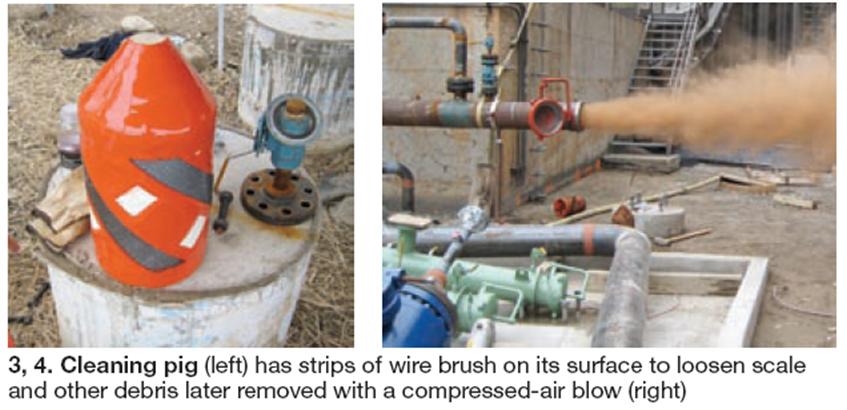
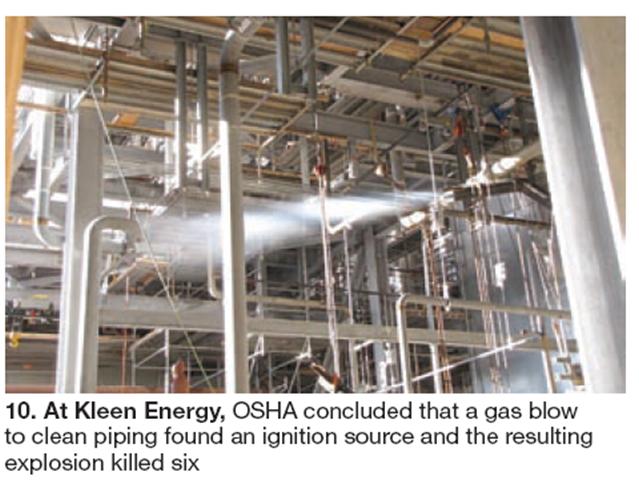
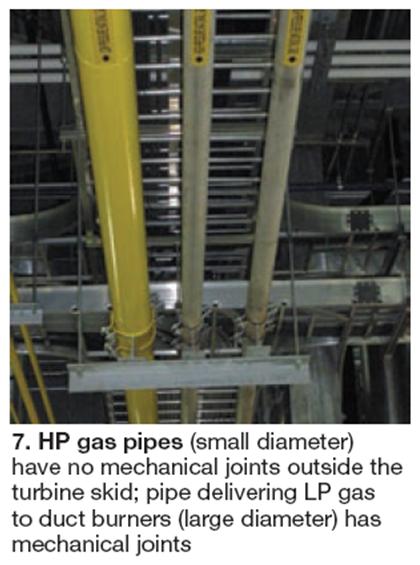
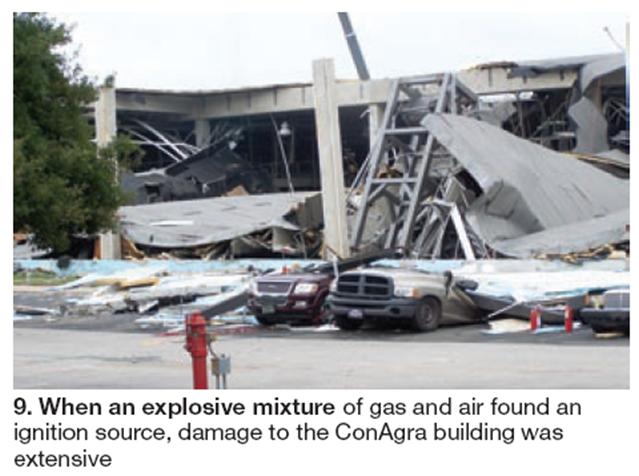
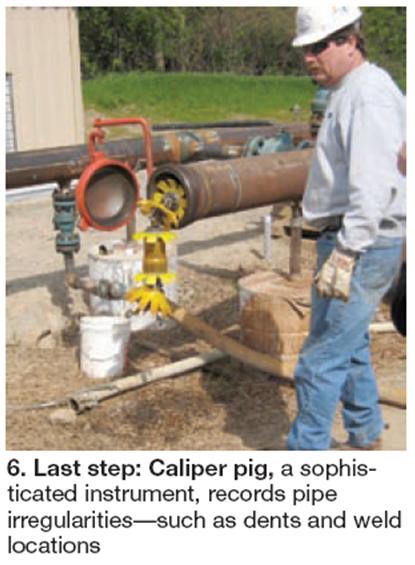
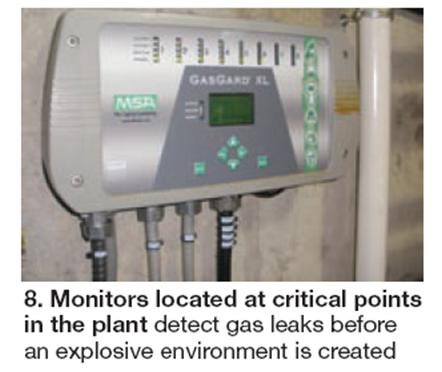
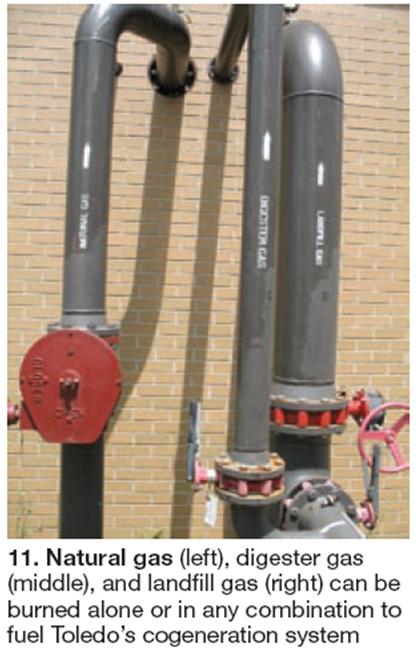
A new concern for safety
Natural-gas usage became a priority item on the national occupational safety agenda in June 2009, when a ConAgra snack-food plant inNorth Carolinaexploded during the purge of a gas line installed to accommodate a new piece of equipment. Some natural gas from the pipe was vented into an interior utility room during startup, instead of to the outside.
When the gas found an ignition source, the explosion destroyed a large part of the building (Fig 9), killed three workers, severely burned four others, and sent a total of 71 people to the hospital. The US Chemical Safety and Hazard Investigation Board investigated and produced a safety bulletin on “Dangers of Purging Gas Piping into Buildings” in September 2009. The CSB is an independent federal agency charged with investigating chemical accidents.
While the industry was digesting the lessons of that safety bulletin, a second explosion in February 2010, at a powerplant under construction inConnecticutfor Kleen Energy Systems, took six lives and sent some 50 more people to the hospital. The Occupational Safety and Health Administration’s investigation concluded that a gas blow to clean a natural-gas delivery pipe was the cause when the gas released found an ignition source (Fig 10).
The accidents caught the attention of American Electric Power Co,Columbus,Ohio. AEP historically has used coal to fuel the majority of its powerplants, but in the last several years it has added natural-gas-fired simple- and combined-cycle plants through acquisitions. Its gas fleet now comprises 23 plants fueled by gas and four others co-firing gas with coal. AEP responded to the rash of fatal accidents by commissioning a review of its own fleet operations.
The company tapped Patrick C Myers to lead the review. Myers, the plant manager atAEP’s Ceredo Generating Station, Huntington, WVa, had more than 20 years of experience at a gas transmission company before joining the electric utility. He led a team consisting of two safety professionals, a training specialist, and engineers with expertise in the gas and chemical industries, electrical equipment design, fire safety, process safety management, piping design, and construction and startup.
The mandate was to evaluateAEP’s own requirements, practices, and physical plant designs associated with the use of natural-gas fuel for venting, purging, blowing down, and line-charging activities at powerplants and to make recommendations for improvement.
As the team surveyedAEP’s system, they found “opportunities for improvement in all the focus areas,” Myers said. One of the most complicated issues in evaluating a natural-gas system is assuring that the electrical equipment installed near the gas piping is in compliance with installation codes, he said.
The proper design of electrical devices and components, conduit, and conduit seals must be evaluated. Conduit seals must be properly poured and inspected to prevent flame propagation through the conduit and wiring system in the event there is an ignition inside the electrical system. A big issue, he said, related to “where gas vents are located and how they are positioned.” Interpretation is required in applying the codes in the field, and a loose interpretation can create a safety concern.
The focus areas, which included design, construction and startup, operation and maintenance, training, management of change and benchmarking, were chosen because they have direct impact on operational safety of the gas systems.
“One of the biggest findings we had was that the design typically was not looking for maintainability of piping,” said Myers. The designers were just laying out pipes where they had to be and designing them to carry whatever they had to carry, but they were not anticipating the need to isolate sections for maintenance. Thus when a particular section of pipe required maintenance, it was necessary to shut down the entire pipe system.
“Now we’re paying attention on new installations so we can isolate sections having appropriate connections to vent, purge, and recharge piping safely and efficiently,” he said. Isolation valves can be installed on pipes as a modification, but it is better and much less expensive to engineer them in from the start. He recommends using OSHA’s Process Safety Management process for layout and design of gas lines and equipment even though it is not a requirement.
Owners must take responsibility for design to assure operability for their plants. “Early in the design process, folks in operations need to be involved in considering gas isolation, purging, and reintroduction activities and how the design supports these important operational and maintenance elements,” said CEC Combustion Safety’s John Puskar.
“I keep seeing plants whereEPCcontractors had a focus on completing the plant for the contracted price without a lot of consideration for operational issues, and especially without consideration for optimizing safety related to coming into and out of service. This is characterized by things like a minimum number of block valves and purge points.
Some facilities have to take hundreds of feet of piping into and out of service for even minor issues. This makes for the release of thousands of cubic feet of gas every time the facilities complete certain maintenance practices.” The way vents are located and oriented with respect to ignition sources “is especially problematic when one considers that the natural gas is not odorized at many sites, so leaks or discharges from relief valves are hard to detect,” Puskar said.
Myers is pleased with the results of theAEPteam’s actions. “We’re making revisions in our emergency action plan,” he said. They’re mostly common-sense measures, based on thinking two or three steps ahead and identifying what should be done in response to an emergency. For example, the quickest way to mitigate a gas emergency is to shut off the gas, so the action plan identifies the most effective way to do that, then asks, If shutoff is not possible at that point, what do we do then; what is the next shutoff point?
The generation sector of the electric-power industry operates with a wide variety of organizational structures. Merchant plants typically are minimally staffed with technicians who, in many cases, come from a background that did not include gas operations, Myers notes. Plant operations and engineering staffs at utilities that are moving from a coal-based operation to more gas operations face a learning curve (sidebar). Training programs specific to natural-gas operation are required to assure that employees have the knowledge to properly operate and maintain their facilities.
In areas that are not typically a power-generation activity, contractors can supply the necessary expertise, Myers said. Examples include design, inspection, and maintenance of cathodic protection systems to prevent degradation of underground gas piping.
Going forward after the Kleen Energy and ConAgra disasters, “I think the word’s getting around that there are going to be changes,” Myers added. “As an industry, we have moved away from using natural gas as the cleaning medium for piping in construction activities.” Gas has been used for pipe blowdowns because it is cheap, available and does the job, butAEPwill not use it, preferring nitrogen or other inert gas instead.
Raising the bar
The two accidents described above prompted the National Fire Protection Assn, Quincy, Mass, to strengthen the safety requirements for gas purging in the National Fuel Gas Code, NFPA 54. But this code applies only to fuel systems up to 125 psig, and explicitly excludes powerplants. So the association wrote a new standard, NFPA 56, for powerplant applications and all flammable gases. It was approved by the NFPA’s Standards Council in August and became effective immediately.
CEC Combustion Safety’s John Puskar is a member of the NFPA 56 Committee, and has been prominent in efforts to educate the power industry about gas piping safety. Gas safety is probably a larger issue for powerplants than for industrial plants, Puskar said, because powerplant gas lines typically have pressures 10 to 30 times higher than an industrial plant’s. In addition, “the quantity of gas piping and the size and number of vessels are substantially more than in most industrial plants,” he added.
“There needs to be a better understanding of the basics of safely purging out of service and into service,” said Puskar. “I have been to many sites where purging out of service simply means venting of natural gas pressure from any convenient vent opening. I have seen these same plants then opening lines with residual natural gas still in them, with no regard or even thought of flushing out the natural gas with an inert substance.
Purging into service, in these same plants, is typically then just closing things up and opening main line blocking valves. There is sometimes no regard for leak-checking or the fact that there has been air-intrusion into the gas lines.”
Once built, the plant requires an inspection and maintenance regimen for its fuel systems. This is more than “just a safety issue,” said Puskar. “This affects reliability.” Poorly maintained piping and gas handling systems can cause turbine damage that will shut down the plant.
Permanent leak-detection monitors (Fig.8) should be installed inside a turbine enclosure or other enclosed areas where a leak could create a hazardous environment, said Myers. Placement would be based on an engineering or hazard study.AEPhas permanent monitors installed in numerous places in its plants. Frequency of inspection can vary, depending on the detector design.
Regardless of manufacture, a quarterly test and calibration of stationary gas detectors is a good practice, he said. Since most gas used in power generation is not odorized, installed monitors are the best warning of a leak. Even if the gas is odorized, the human nose is not the most reliable detection device.
Going unconventional
Concerns about emissions of carbon dioxide as well as of Clean Air Act criteria pollutants—such as sulfur dioxide, oxides of nitrogen, and particulates—are driving a trend to greater use of renewable energy for power generation, and alternatives including digester gas and landfill gas (LFG) are finding favor. Use of unconventional or “green” gases brings with it some different issues, however, in addition to those described above.
In fall 2010, the Bay View Wastewater Treatment Plant operated by the City of Toledo, Ohio’s, Dept of Public Utilities (DPU), a unit of the Div of Water Reclamation, completed a project to install gas-turbine cogeneration for backup power and to addLFGto the blend of natural gas and digester gas fueling its 10-MW Taurus 60-powered 1 x 1 combined-cycle powerplant (Fig 11).
The wastewater treatment plant has used digester gas for years to fuel reciprocating engines powering other equipment. Since 2006, six new recips with a combined capacity of 12 MW have been added for backup power, of which one is a black-start unit; three are powered by natural gas and two others by digester gas.
Addition of the cogeneration plant broke new ground for the DPU, however. It was the treatment plant’s first gas turbine, its first combined cycle and, not least, the first time landfill gas was added to the wastewater-treatment plant’s fuel mix.
Biogas requires more fuel treatment than natural gas, and its heating value is lower, so more volume is needed to obtain the same performance, said Ken Berg, sales manager for Solar Turbines Inc,San Diego,Calif, the plant’s turbine supplier. Biogas typically requires “some pretty substantial cleaning,” added Martin F Ellman, PE, senior manager for energy technology at Cleveland-based Middough Inc, Cleveland, the plant’s architect/engineer.
The city-owned Hoffman Road Landfill lies about two miles away from the Bay View plant. InfraSource Services LLC,Glen Ellyn,Ill, laid a 9000-ft-long, 10-in.-diam high-density polyethylene pipe to deliver theLFGto Bay View.
TheLFGcarrier pipe shared the excavation with a fiberoptic cable and a 5-kV feeder cable to deliver power from the cogeneration plant back to the gas-treatment facilities at the landfill. The pipe and cables were laid mostly in a cut-and-cover trench with at least 36 in. of cover, but they had to go much deeper to pass under three railroad rights-of-way.
Using horizontal directional drilling, the contractor installed them 22 ft deep for 200 ft and 90 ft, respectively, below two sets of tracks, and 14 ft deep for 130 ft below a third set. Directly under the tracks, they were protected by a 30-in.-diam steel casing.
The configuration of the pipeline makes pigging risky, said Michael Schreidah, PE, the city’s project manager, because if a pig became lodged deep under the tracks, it would be costly to clear. Instead, he has added drainage traps and improved the functionality of the gas compressor separator at both the landfill and the cogen plant.
Gas treatment at the landfill is necessary because LFGcontains siloxanes and other impurities that must be stripped out before it can be used for power generation. The blending of natural, digester, and landfill gases before combustion occurs at the cogeneration plant. Access process details at http://www.ccj-online.com/bay-view-cogeneration/.
Solar Turbines furnished and installed the cogen plant’s power island—including gas turbine and generator, steam turbine and generator, boiler, HRSG, steam condenser, deaerator, HP and LP compressors, gas scrubbers, two cooling towers and distribution switchgear. Barton Malow Co,Southfield,Mich, was general contractor for the balance of plant and construction of related facilities.
A 23-yr DPU employee, Schreidah was the project manager for the engine-based backup power systems as he was for the construction of the cogen plant and theLFGpipeline. His experience with the reciprocating engines did not prepare him for the surprises that came with the cogen plant.
Shortly before the cogen plant was commissioned, he said, “we experienced high levels of condensate in the landfill gas that was not removed by the gas scrubber. We suspect that water had collected in the 9000-ft landfill-gas pipeline, which forced us to shut down the operation of the gas-turbine system.”
He also has found free water in the LFG pipeline at certain times of the year, notably June, July, and December. He has dealt with condensate in digester gas, and said that this is not condensate, but free water, entering the line as water. Holland Associates,Toledo, the city’s engineer for the landfill, also is surprised by the water. The engineer is investigating, but has not yet found an answer.
Landfill gas also requires more treatment than digester gas, Schreidah said. It has less methane than digester gas but more carbon dioxide, more sulfide and, as mentioned, siloxane. The siloxane should be extracted from the fuel by media in the gas scrubber towers, and the media must be changed every three years, he said.
One surprise had more to do with constructing an unfamiliar type of plant than with the green fuel. The design for the cogen plant began in 2006, and equipment was ordered in 2007, simultaneously with the start of construction. The equipment arrived in the summer of 2008 and was installed in fall 2009.
By the time commissioning was completed in fall 2010, the warranties had expired on much of the equipment because they were for 18 months after delivery or 12 months after startup. He was unprepared also to store the delivered equipment on site and had to store it at the landfill, necessitating double shipment before final installation. If he had to do it again, he would have a storage yard on site, Schreidah said. CCJ



